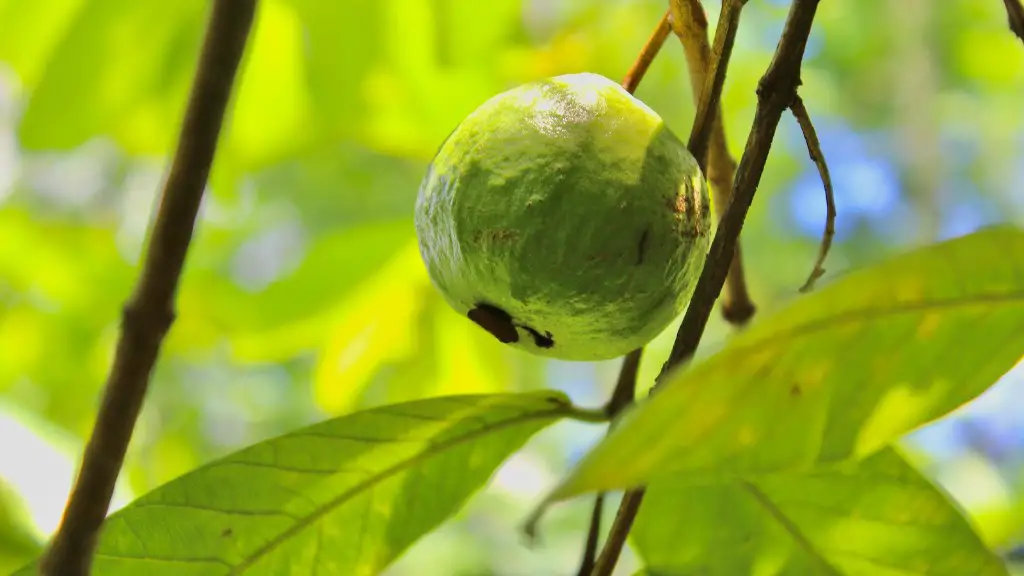Avocado trees, otherwise known as Persea americana, are widely loved and abundant in many parts of the world, especially in the United States. But like any tree or plant, they can face a number of issues that can lead to poor health or even death. Many times the problem can be addressed with proper care, but sometimes a more advanced solution is needed. Therefore, it’s important to first understand what could be wrong with an avocado tree before seeking help.
There are a few common issues that can afflict avocado trees. One is water related, such as over or under watering, which can lead to branch dieback, yellowing of leaves, or even root rot. This is often caused by a lack of proper irrigation or a failure to properly water the tree. Poor soil conditions, especially inadequate drainage or excessive salt, can also lead to water issues.
Sunlight is also vital for an avocado tree’s health, as too little can result in poor branching or small foliage. Diseases like leaf spot, root rot, or fungal infections can also affect avocado trees, often caused by overwatering or wet conditions. Aphids and other pests can also damage avocado trees if not taken care of in a timely manner.
Avocado trees are also susceptible to adverse weather conditions like cold, wind, or frost, so they should be planted in an area that is protected from these forces of nature. Proper pruning is also essential to an avocado tree’s health, as it helps encourage good branching and proper fruit formation.
For the best advice, it might be wise to enlist the help of a professional tree care expert. They have the knowledge and experience to assess and address any issues with an avocado tree. Apartment dwellers can also enlist the help of a local home garden center to assess and determine the best course of action.
But there are also simple things that one can do at home to help an ailing avocado tree. For example, watering the tree on a regular basis and making sure there is proper drainage can go a long way. Fertilizing the tree with a mix of potassium, phosphorus and nitrogen can also help promote healthy growth and soil conditions. Wrapping the trunk of the tree with a tree wrap or mulch can provide extra protection.
Adopting proper avocado tree care habits can help prevent the majority of problems, while taking the necessary steps to address existing issues can help keep an avocado tree healthy and vibrant.
Water Issues
Water issues are some of the most common problems afflicting avocado trees. They can be caused by poor soil conditions, inadequate drainage, or excessive salt, but are often the result of a failure to properly water the tree. The amount and frequency of water needed is determined by the age of the tree and the local climate. For instance, younger trees will need to be watered more often than more mature trees. Watering should be done deeply and evenly, so that all of the roots have access to moisture, but not too often that it causes root rot.
It is also important to check the drainage in the soil, as excess water can damage the roots, leading to poor growth or even death. If the soil is poorly drained, it may be necessary to amend it with organic matter like compost to help improve water absorption and drainage.
Avocado trees can also be planted in raised beds or containers to help improve drainage and moisture retention. A three- to four-inch layer of mulch can also help protect the soil and retain moisture.
Sunlight Issues
Sunlight is essential for the health of avocado trees. If the tree gets too little sunlight, it can be prone to weak or poor branching and small foliage. These trees should get six hours of direct sunlight every day to stay healthy. If the tree is not getting enough sunlight, it can be moved to an area that receives more direct sunlight. Shade cloth can also be used to block some of the sun’s rays.
Foliage can also suffer from insufficient sunlight. Leaves can become limp or yellow, and the tree may fail to produce adequate fruit. If this is the case, more light may be needed via artificial sources, such as grow lights. Just be sure to monitor the light levels closely so that the tree isn’t exposed to too much.
Weather Issues
Adverse weather conditions can also damage avocado trees, such as cold, wind, or frost. These trees need to be planted in an area that is sheltered from such extreme conditions. High wind can cause branches or fruit to be damaged, while cold or frost can damage the tree’s roots or foliage.
If possible, the tree should be planted in a location that is sheltered from direct wind. Windbreaks, such as fences or hedges, can help protect the tree from windy conditions. If the area is prone to frost, rain covers can be used to insulate the tree and protect it from the cold.
Pruning and Fertilizing
Periodic pruning can also help keep an avocado tree healthy and shapely. Pruning helps to maintain the tree’s overall form and encourages healthy foliage and fruit production. A good rule of thumb is to prune 1/10th of the tree each year. Removing dead or excessive growth can also help improve air flow, which can help reduce fungal issues like mildew.
Fertilizing avocado trees can also help boost their health. The best fertilizer should contain nitrogen, phosphorus, and potassium in balanced proportions. It’s best to apply fertilizer during late winter or early spring, and it should be applied evenly and deeply around the base of the tree.
Pests and Diseases
Pests and diseases can ravage avocado trees and should be addressed quickly if spotted. Common pests include aphids, mites, and scale, which can damage leaves, fruit, and wood. For aphids, using a strong stream of water from a hose can be effective in removing them from the tree. For more serious infestations, insecticides can be used, but should be employed with care as they can harm beneficial pollinators as well.
Diseases also pose a major threat to avocado trees, with fungal infections being the most common. Many fungal problems are caused by wet conditions or poor air flow. Pruning the tree to improve air circulation and avoid overwatering can help reduce the risk of disease.
Solutions for Ailing Avocado Trees
Depending on the nature of the problem, there are various techniques and strategies available to address ailing avocado trees. In many cases, simple things like proper irrigation and fertilization can go a long way in restoring an avocado tree’s health.
However, more serious issues may require professional help. Consulting a local tree care expert or home garden center can help diagnose and treat complex issues. Following their recommendations and making any necessary adjustments can help keep an ailing tree alive and healthy.
Conclusion
Taking good care of an avocado tree requires dedication, diligence, and knowledge. It’s important to understand what could be wrong with the tree and take action to address the issue. Through proper irrigation, fertilization, pruning, and protection, a well-cared-for avocado tree should remain healthy and vibrant.



